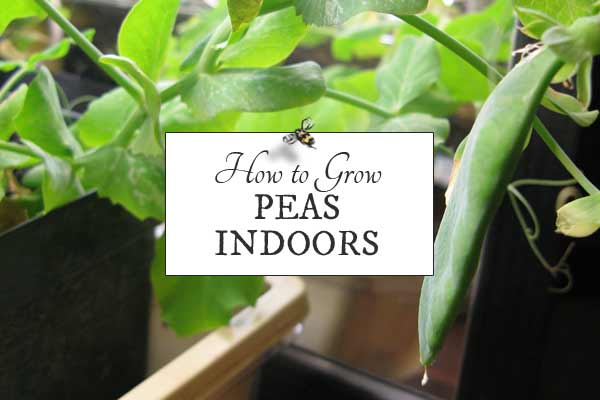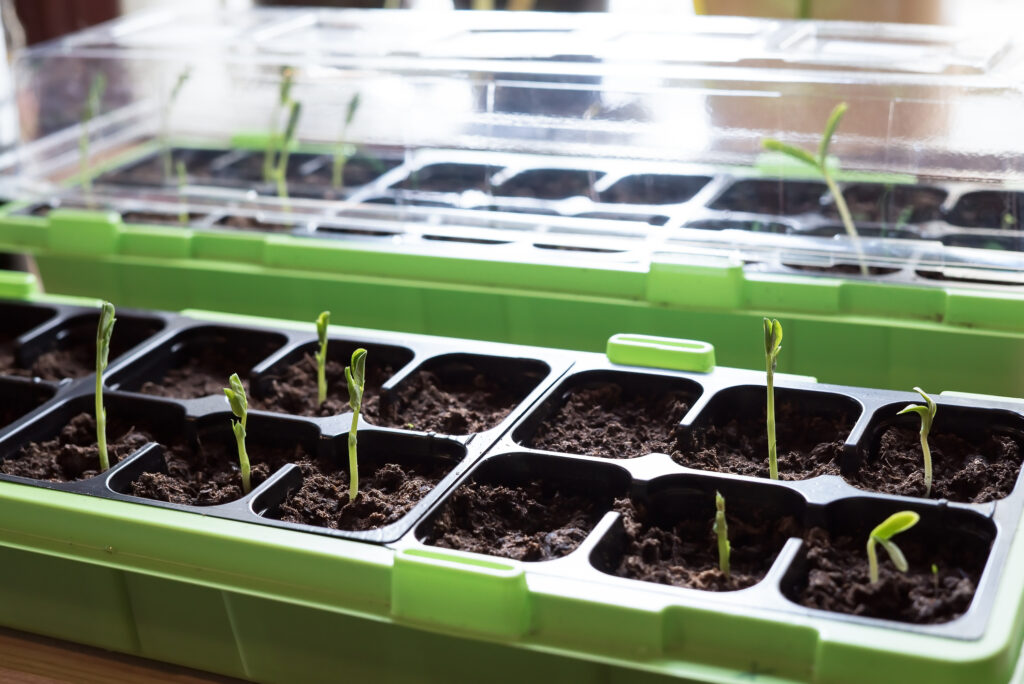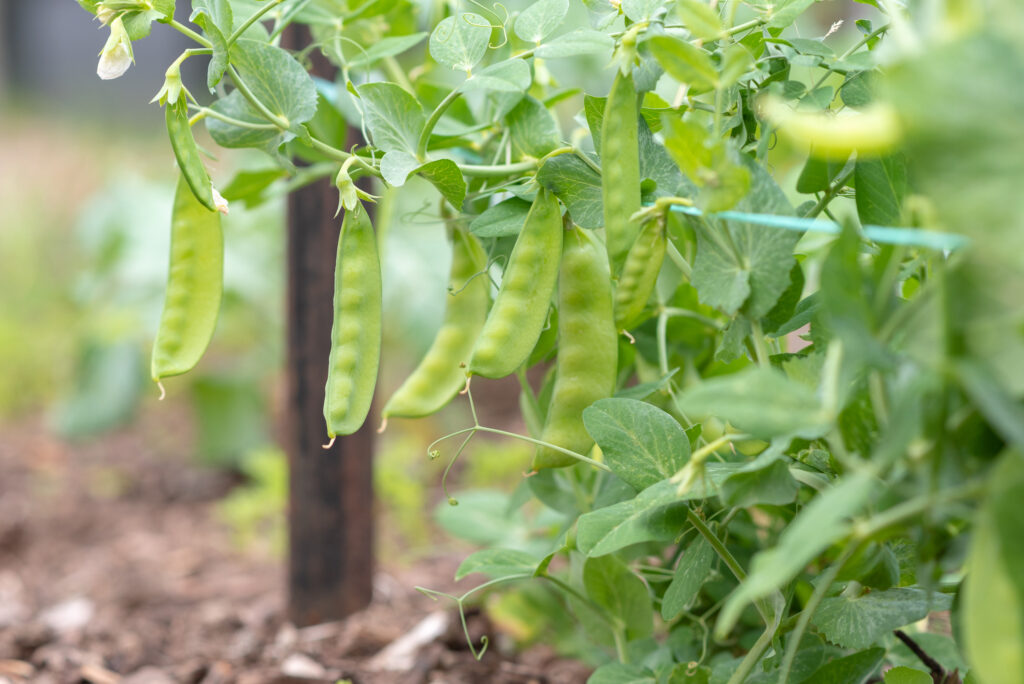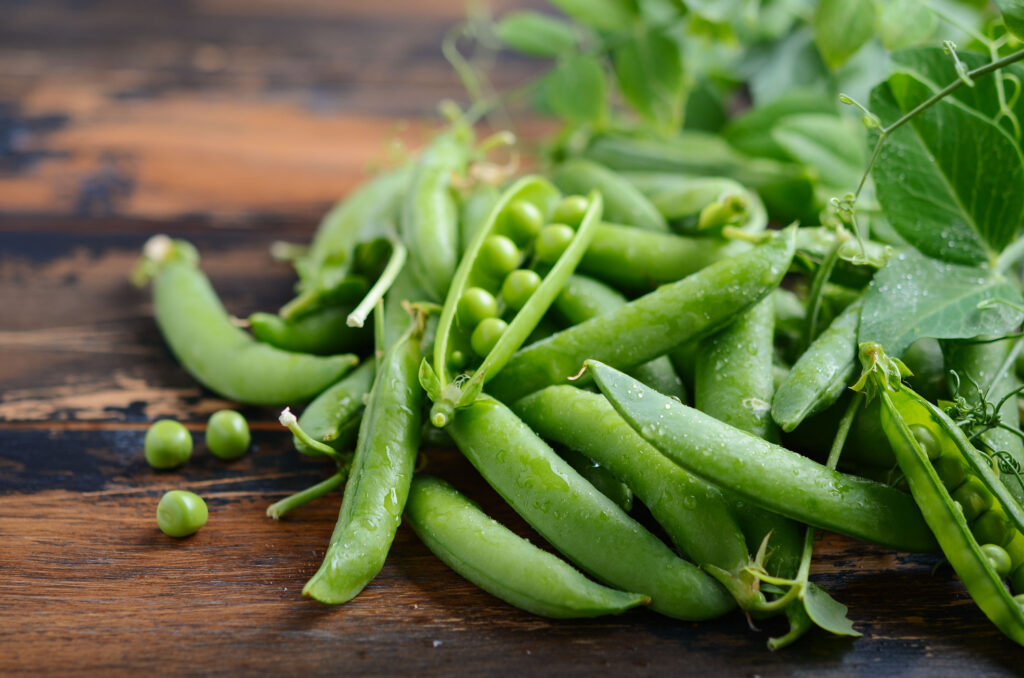Early spring weather is sometimes cool, inclement, and downright gray. Perfect for peas! If you are a fair-weather gardener, well then, you’ll have to buy your peas at the market. On the other hand, if you want to partake in the best, sweetest tasting peas you have ever had, you will have to ignore or brave the weather and get outdoors in early spring.
Of course, early spring planting required additions of proper soil amendments and preparation for peas back in the fall. Major soil cultivation in early spring is important to avoid, especially in clay-loam soils. Excessive compaction becomes more probable in cold, wet soils. Compacted soils restrict rooting and leave them void of necessary oxygen. However, if you did not get the chance to enhance your soil last fall, fret not, add any proper amendments and lightly cultivate your pea rows 4 to 6 in. deep. This will work for this season.
Sugar snap peas are a garden favorite thanks to their sweet, crisp flavor and satisfying crunch. There’s nothing quite like plucking a freshly harvested snap pea right off the vine and enjoying it raw as a tasty snack. While sugar snap peas thrive in cool weather, getting them off to an early start indoors can help ensure a bountiful harvest before summer heat arrives.
Starting sugar snap peas indoors allows you to get a jump on the growing season With the right approach, you can gain up to a month or longer of production compared to direct sowing sugar snap peas in the garden Read on to learn techniques for successfully starting sugar snap pea seeds indoors.
Why Start Sugar Snap Peas Indoors?
There are several key advantages to getting a head start on growing sugar snap peas inside
-
Lengthens Harvest Period – Indoor planting allows snap peas to mature earlier, extending the harvest weeks ahead of direct sowing outside.
-
Avoids Germination Issues – Starting seeds indoors prevents spotty, poor germination that can occur when direct sowing peas in cold, wet spring soil
-
Beats Summer Heat – Peas prefer cool weather and productivity declines once hot temperatures arrive. Indoor planting maximizes your yield before summer.
-
Efficient Use of Space – Starting seeds indoors makes use of indoor growing space when it’s still too cold to plant outside.
-
Grow Specialty Varieties – Indoor planting allows you to try rare or expensive sugar snap pea varieties you might not risk direct sowing.
As long as sugar snap peas are transplanted properly, an early indoor start shouldn’t stunt their growth or productivity. The benefits easily make it worthwhile.
Selecting Varieties for Indoor Planting
When choosing sugar snap pea varieties to start indoors, look for types that:
-
Mature Quickly – Seek out fast-maturing varieties that are ready for harvest in 60 days or less. This gives them enough time to ripen fully before summer heat hits.
-
Compact Size – Dwarf, bushy, and short-vined pea varieties adapt best to transplanting with minimal disturbance to their growth.
-
Disease Resistance – Select varieties labeled as resistant to common pea diseases like powdery mildew and Fusarium wilt. This helps avoid setbacks after transplanting.
-
Heat Tolerance – Choose varieties known for retaining high productivity even as temperatures climb in late spring and early summer.
Some excellent sugar snap pea candidates for indoor starts include:
- Sugar Ann – Very compact, early variety well-suited to container growing.
- Sugar Sprint – Quickly maturing, disease resistant variety and an All-America Selections winner.
- Super Sugar Snap – A classic, heavy yielding snap pea with vines reaching 6-7 feet.
- Cascadia – Bears high yields on 2.5-3 foot vines; disease resistant.
- Sugar Lace – Heirloom type with pretty violet blooms and sweet snaps.
When to Start Sugar Snap Peas Indoors
Timing is crucial when it comes to getting the most out of an indoor start for sugar snap peas. Here are some general timelines to follow:
-
Start seeds 4-6 weeks before your last expected spring frost date. This gives enough time for strong root development and leaf growth before transplanting outside.
-
Plan to transplant seedlings 2-3 weeks before your average final frost. The nearly mature starts can withstand some cold but don’t do well transplanting too early.
-
Factor in days to maturity for the variety. Compact types ripening in 50-60 days or less provide the best chance for a harvest before summer.
-
Adjust dates appropriately based on your local climate conditions. Those in very sheltered areas or warmer microclimates can often plant a little earlier.
Getting the timing right takes some planning, but it maximizes your harvest duration for the effort.
Providing the Proper Indoor Growing Environment
Creating the right conditions for starting sugar snap pea seeds is vital to get seeds off to a vigorous start. Here are some tips:
-
Use seed starting mix – Blends made for seedlings provide ideal texture and nutrients.
-
Allow good drainage – Adding perlite or vermiculite to starting mix improves drainage to prevent damping off disease.
-
Warmth for germination – Maintain temperatures of 70-75°F until seeds sprout. Consider a heat mat or grow lights to provide warmth.
-
Moisture for germination – Keep seeds evenly moist but not soaked for best germination rates. Gentle misting helps maintain moisture.
-
Prompt lighting after sprouting – Move to a sunny window or under grow lights as soon as seeds germinate to prevent leggy growth.
-
Adequate airflow – Good ventilation helps prevent fungal issues like damping off disease. Avoid crowding.
Giving sugar snap pea seeds the right conditions early on sets them up for transplanting success.
Step-By-Step Process for Starting Sugar Snap Peas
Here is a summary of the key steps for starting sugar snap pea seeds indoors:
-
Fill containers with moistened seed starting mix – Allow good drainage; peat or cow pots work well.
-
Plant seeds 1 inch deep – Cover completely for darkness needed to germinate.
-
Maintain ideal temps and moisture – 70-75°F and evenly moist is optimal to sprout seeds.
-
Move to light immediately after sprouting – Prevent leggy growth by providing ample light.
-
Thin seedlings – Clip off all but the strongest seedling in each container.
-
Harden off plants – Gradually expose to outdoor conditions over 7-10 days before transplanting outside.
With attentive care while starting and hardening off, sugar snap pea transplants will be primed for excellent performance in the garden.
Transplanting Peas Outside
Careful technique when transplanting is key to avoiding setbacks to growth and productivity:
-
Transplant on an overcast, cool day to reduce stress on seedlings.
-
Disturb roots as little as possible when removing from containers.
-
Space rows 1-2 feet apart for good vine growth and easy picking access.
-
Plant seedlings 4-6 inches apart in rows (closer for dwarf types).
-
Set seedlings 1-2 inches deeper than they were growing indoors. Firm soil around roots.
-
Water transplants thoroughly right after planting to remove any air pockets in soil.
-
Put up trellises and supports at planting time to avoid later root damage.
With minimal disturbance, adequate spacing, and protection from weather extremes, transplants should demonstrate vigorous, rapid growth.
Caring for Sugar Snap Peas After Transplanting
Once your starts are settled into the garden, they need attentive care to stay healthy and productive:
-
Water regularly with drip lines or soaker hoses to keep soil evenly moist.
-
Use row cover fabric at night if temperatures drop low enough to threaten plants. Remove during day for pollination.
-
Mulch around plants to conserve moisture and reduce weeds. Straw and grass clippings work well.
-
Fertilize every 2-3 weeks with a balanced organic plant food or compost tea.
-
Monitor for pests and diseases. Take prompt control action to keep plants in top form.
-
Harvest regularly once pods fill out. Pick before pods become stringy and mature peas cause vines to stop producing.
Reward your indoor-started sugar snap pea plants with attentive care and you’ll reap the benefits of an earlier and longer harvest period.
Troubleshooting Indoor Started Sugar Snap Peas
Even when you follow best practices, potential problems can pop up when starting sugar snap peas indoors:
-
Leggy, weak growth – Insufficient light often causes this. Move under grow lights or to a sunnier spot.
-
Damping off disease – Fungal issue causes stems to rot at soil level. Improve airflow and avoid overwatering.
-
Slow growth after transplanting – Normal for some temporary shock. Growth will pick up again if transplants are cared for properly.
-
Poor pod set – Cool weather after transplanting can delay flowering and pod production until things warm again.
-
Low yields – Very hot weather causes sugar snap peas to be less productive. Not much can be done other than selecting heat-tolerant varieties.
-
Vines dying back early – Natural light decline in productivity as plants age. Keep picking pods to encourage further flowering.
While problems can arise on occasion, attentive care reduces the likelihood of serious setbacks from an indoor start.
Enjoy an Early Snap Pea Feast
Starting sugar snap peas indoors extends harvests by weeks and avoids disappointing germination issues direct sowing in cool spring soil. With planning, careful technique, and attentive growing conditions, home gardeners can gain up to a month or more of enjoying fresh snap peas. The reward of harvesting crisp, sweet sugar snap peas right from your garden makes an indoor start worthwhile. Follow this guide for tips and techniques to successfully start your sugar snap peas indoors this season!

Garden or English Peas
English peas are used for shelling. You just eat the pea, not the pod. Our favorite varieties include:
- Green Arrow is one of the most popular shelling peas.
- Wando is a popular shelling type to stretch later into warmer spring temps.
- Little Marvel a.k.a Extra Early is the quintessential English garden pea. Crossing the pond, as they say, way back in 1908. It has been popular ever since.
How To Plant Peas

The best pea crops are started early in the spring, as mentioned. While all your other vegetable seed sits enviously, you can start to prepare your pea seed when average daytime temperatures reach 60° to 65°F, with soil temps. in the 40° to 50°F range.
Peas can be direct sown or started indoors 3 to 4 weeks ahead of planting out in individual, transplantable peat pots or Jiffy starter cells. Indoor seeding works well for sugar snap, English, and snow peas. Germination time will be cut down by pre-soaking seeds for 1 to 2 hours prior to planting. Be patient, in cold soils (around 40°F) pea seeds can take more than 20 days to emerge. As with any seeds the warmer the soil temps the quicker germination will be.
With legumes (beans & peas) it is important to use fresh inoculant powder, prior to sowing your pea seeds. Some folks will place the inoculant in a zip-lock baggie and drop in the freshly pre-soaked seeds to give them a gentle “shake ‘n’ bake” treatment, to coat the seeds. For direct sowing peas, it is also perfectly respectable to sprinkle inoculant on the soil-bed, after creating your 1 to 2 in. deep planting furrows. Space pea seeds 2 to 4 in. apart in rows that are 18 in. apart, then there is no thinning needed.
Top Jung Tip: When soils are cool and wet, shallow planting is best. If soils are warm and dry, plant seeds at the full 2 in. depth for best success.

For maximum yields give peas something to climb on. Most modern varieties will grow on vines 2 to 4 ft. tall, so you can erect standard trellis, fencing, or be creative with materials you have around the house like bamboo stakes, old chicken wire, or random tree branches that can work fine. Peas don’t need too much encouragement to climb.
Young pea plants can be quite vigorous, so keep a close watch on the soil moisture. The soil should be kept evenly moist but not soggy. Use the 1 inch per week watering plan to keep them happy. If their leaves start to develop a pale-yellow cast, you may want to fertilize with a good water-soluble, vegetable specific plant food like Neptune’s Harvest Fish and Seaweed 2-3-1 formula. With legumes, always avoid fertilizers higher in nitrogen, which can cause vigorous vine growth with little to no pod production.

Just like with beans, there are many different types of peas. Peas are grouped by pod types, growth habits, and basically how they are used.
How to Easily Start Peas Indoors: They are Ready in About 2 Weeks!
FAQ
Should you start sugar snap peas indoors?
Peas can be direct sown or started indoors 3 to 4 weeks ahead of planting out in individual, transplantable peat pots or Jiffy starter cells. Indoor seeding works well for sugar snap, English, and snow peas. Germination time will be cut down by pre-soaking seeds for 1 to 2 hours prior to planting.
Should I soak my sugar snap pea seeds before planting?
Soak Sugar Snap Peas Before Planting to Aid Germination
The reason to soak peas is to speed the process of germination along. Seeds have seed coats to protect themselves.
How early should you start sweet peas indoors?
“Sweet peas can be started indoors up to six to eight weeks before the last spring frost, and then transported outdoors in early spring,” she explains. “Just remember to space the seeds at least two-inches apart, or twine each plant as they grow, so they’re easy to separate when it’s time to move them outside.”
How do you germinate sugar snap peas?
Fill a module tray with good multi purpose compost, wet it till saturated, push two or three peas into each module, cover with more compost, water again, leave somewhere at room temperature but out of direct sun, keep moist the peas should germinate in about ten days.
Can you grow sugar snap peas indoors?
Although this is a more generic guide for how to grow peas indoors, you’ll find knowing how to grow sugar snap peas indoors won’t be too different (as long as you follow the directions on the seed pack). Will your peas pollinate indoors?
When should you plant sugar snap peas?
Sow your snap peas at the end of the cold season. Sugar snap peas flourish in cooler temperatures. You can put your seeds in the ground as early as the final frost of winter, just before the onset of spring. Even young plants will be hearty enough to survive one or two minor frosts in the interim.
How long do sugar snap peas take to grow?
Pick the peas when they young and tender to eat fresh or leave on the vine to dry if you want to add them to a soup. Sugar Peas – These take between 40 and 45 days from seed to harvest, sugar snap peas are harvested when the pods are fully developed and have small peas inside. They are great straight from the vine or in a salad.
